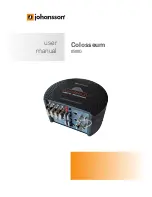
En-
29
Network/USB Features
The following diagram shows how you can connect the
tuner to your home network. In this example, it’s
connected to a LAN port on a router, which has a 4-port
100 Base-TX switch built-in.
■
Ethernet Network
For the best results, a 100 Base-TX switched Ethernet
network is recommended. Although it’s possible to play
music on a computer that’s connected to the network
wirelessly, playback may be unreliable, so it is
recommended to use wired connections.
■
Ethernet Router
A router manages the network, data-routing and supplying
of IP addresses. Your router must support the following:
• NAT (Network Address Translation). NAT allows
several networked computers to access the Internet
simultaneously via a single Internet connection. The
tuner needs Internet access for Internet radio.
• DHCP (Dynamic Host Configuration Protocol).
DHCP supplies IP addresses to the network devices,
allowing them to configure themselves automatically.
• A router with a built-in 100 Base-TX switch is
recommended.
Some routers have a built-in modem, and some ISPs
require you to use specific routers. Please consult your
ISP or computer dealer if you’re unsure.
■
CAT5 Ethernet cable
Use a shielded CAT5 Ethernet cable (straight-type) to
connect the tuner to your home network.
■
Internet Access (for Internet radio)
To receive Internet radio, your Ethernet network must
have Internet access. A narrowband Internet connection
(e.g., 56 K modem, ISDN) will not provide satisfactory
results, so a broadband connection is strongly
recommended (e.g., cable modem, xDSL modem, etc).
Please consult your ISP or computer dealer if you’re
unsure.
Notes:
• To receive Internet radio with the tuner, your
broadband Internet connection must be working and
able to access the Web.
Consult your ISP if you have any problems with your
Internet connection.
• The tuner uses DHCP to configure its network settings
automatically. If you want to configure these settings
manually, see “Network Setup” (
page 32).
• The tuner does not support PPPoE settings, so if you
have a PPPoE-type Internet connection, you must use
a PPPoEcompatible router.
• Depending on your ISP, you may need to specify a
proxy server to use Internet radio. If your computer is
configured to use a proxy server, use the same settings
for the tuner (
page 32).
■
Server playback
The tuner can play digital music files stored on a
computer or media server and supports the following
technologies:
• Windows Media Player 11
• Windows Media Player 12
• Windows Media Connect 2.0
• DLNA-certified media server
If the operating system of your computer is Windows
Vista, Windows Media Player 11 is already installed.
Windows Media Player 11 for Windows XP can be
downloaded for free from the Microsoft web site.
• The computer or media server must be on the same
network as the tuner.
• Each folder may contain up to 20000 music files, and
folders may be nested up to 16 levels deep.
Note:
Depending on the media server, the tuner may not
recognize it, or may not be able to play its music files.
■
Remote playback
• Windows Media Player 12
• DLNA-certified (within DLNA Interoperability
Guidelines version 1.5) media server or controller
device
• Setting varies depending on the device. Refer to your
device’s instruction manual for details. If the
operating system of your personal computer is
Windows 7, Windows Media Player 12 is already
installed. For more information, see the Microsoft
web site.
Connecting to the Network
Network Requirements
Internet radio
Modem
Router
Computer or media server
Server Requirements












































